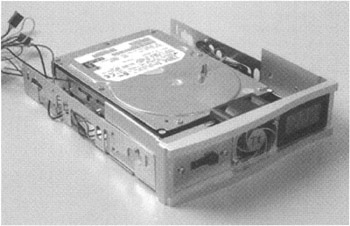Cooling Hard Disks
Cooling Hard Disks
Not all hard disks require cooling. This includes drives with a spindle rotation speed of 5,400 rpm. Disk drives intended for the home or office rarely require cooling.
Nevertheless, there are many high-performance disk drives available. These drives include models with a rotation speed ranging from 7,200 rpm to 15,000 rpm. They often include a large amount of cache memory and high-performance chips in the built-in controller. The operation of these electronic components, combined with the operation of mechanical elements, causes intensive heat emission. As a result, high-performance hard disks frequently require appropriate cooling, especially if they are installed in compact computer cases.
The replacement life of the hard disk depends on its operating temperature. When the drive temperature rises above the limit specified by the hardware manufacturer, it is advisable to use specialized cooling devices. For example, the temperature limit for the IBM hard disks is 55°C (131°F).
Some computer cases, such as the Thermaltake Xaser, can ensure a constant flow of cool air around the hard disk. For sufficient air cooling, 80 mm fans are installed in the hard disk compartments of these cases that constantly blow cool air around the disks. Some cases have special compartments where additional fans can be installed when necessary. When air-cooling is not sufficient, it is possible to install an additional cooler for hard disks. Such devices are not hard to find.
There are several types of hard disk coolers. The first type includes coolers for the electronic components of a hard disk. These devices usually comprise only one fan. The fan is fastened below the disk and cools its controller. Such coolers rarely require additional room within the case. Because they direct the airflow toward the lower part of the hard disk drive, they can decrease the temperature not only of the chips, but also of the mechanical components of the disk. Unfortunately, the design of some cases doesn't provide the possibility of using such coolers.
The second type of cooling device of the second type is a heatsink fastened to the drive. They are used mainly to cool the hard drive case. Because the surface of the hard disk case is rarely flat, it can be difficult to fasten the heatsink to the disk. The general efficiency of such devices is far from perfect, because they usually adjoin only part of the disk case surface. Because of this, heatsinks for hard disk are used rarely as standalone coolers.
The third type includes devices that ensure ventilation for the entire hard disk. This device blows cool air around the entire disk case. Such coolers are stationary containers for hard disks. Disk is fastened within the container using screws, just as the disk is fastened within the case. The entire unit is placed into an available compartment of the 5-inch drive within the system unit case. Fans are installed on the front panels of such devices. These fans blow cool air from the room into the system unit. Depending on the modification, such coolers can have from one to three fans on the front side. Both the efficiency and the noise level depend on these fans. An example of such a cooler is shown in Fig. 10.25.

Figure 10.25: HardCano 3 cooler for hard disks
Finally, the fourth type of device is a combined cooler. They can provide all combinations of the previously listed cooling facilities. They typically comprise heatsinks for cooling the disk case and fans for air-cooling. Such coolers take one 5-inch compartment in the case, and the hard disk is fastened within the device in a manner similar to that for the third type of coolers. The top surface of the disk being cooled adjoins the heatsink; cool air is supplied from the front and/or from below. Such coolers are the most efficient and, therefore, the most expensive.






